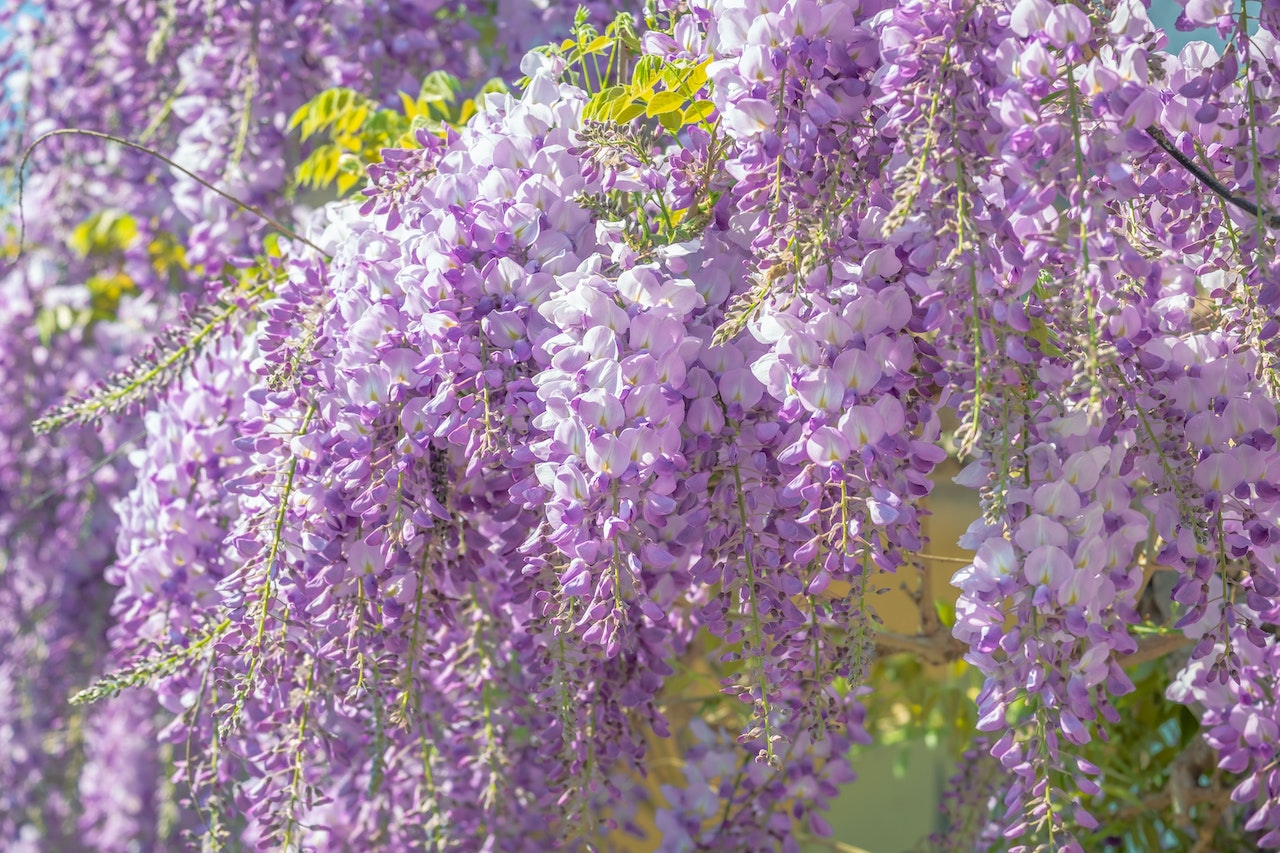Meaning Of Wisteria - Symbolism, Significance, And Interpretations
The plant produces long clusters of delicate flowers that hang down in a graceful manner, adding a touch of elegance to any garden or landscape. But what is the meaning of wisteria? In this article, we will explore the symbolism and significance of this lovely plant.
Author:Ava MartinezReviewer:Michele SievertMay 11, 202315 Shares397 Views

Wisteria is a beautiful and fragrant flowering plant that is native to China, Korea, and Japan. It has become a popular ornamental plant in many other parts of the world, including the United States and Europe.
The plant produces long clusters of delicate flowers that hang down in a graceful manner, adding a touch of elegance to any garden or landscape. But what is the meaning of wisteria? In this article, we will explore the symbolism and significance of this lovely plant.
The History Of Wisteria
Wisteria has a long and rich history in Chinese and Japanese culture. In China, it is known as "zǐ táo" and is associated with the idea of long life and immortality.
In fact, the wisteria was often planted in gardens belonging to royalty and wealthy families as a symbol of prosperity and longevity.
In Japan, wisteria is called "fuji" and has been celebrated in art and literature for centuries. It is also associated with the idea of immortality and is often depicted in Japanese gardens and paintings.
Meaning Of Wisteria And Symbolism Of Wisteria
The symbolism of wisteria varies depending on the culture and context in which it is used. However, some common meanings associated with the plant include.
The Colors Of Wisteria
The color of wisteria flowers can also hold significant symbolism. The most common colors for wisteria flowers are purple and white, but there are also varieties that bloom in pink, blue, and even yellow. Here are some of the symbolic meanings associated with the different colors of wisteria.
- Purple - Purple is a color often associated with royalty, luxury, and nobility. Purple wisteria can therefore be seen as a symbol of wealth and prosperity, as well as grace and elegance.
- White- White is a color often associated with purity, innocence, and spirituality. White wisteria can therefore be seen as a symbol of spirituality and enlightenment, as well as innocence and purity.
- Pink- Pink is a color often associated with love, romance, and femininity. Pink wisteria can therefore be seen as a symbol of love and romance, as well as femininity and grace.
- Blue- Blue is a color often associated with calmness, serenity, and tranquility. Blue wisteria can therefore be seen as a symbol of peacefulness and calmness, as well as introspection and reflection.
- Yellow- Yellow is a color often associated with happiness, joy, and sunshine. Yellow wisteria can therefore be seen as a symbol of happiness and positivity, as well as brightness and optimism.
Wisteria In Feng Shui
In Feng Shui, wisteria is often used as a symbol of prosperity and abundance. The plant is believed to bring good luckand financial success to those who cultivate it. Here are some tips for using wisteria in Feng Shui.
- Placement- Wisteria is best placed in the southeast or east sectors of a home or garden, as these areas are associated with wealth and prosperity in Feng Shui.
- Color - As mentioned earlier, the color of wisteria can also hold symbolic significance in Feng Shui. Purple is often the preferred color for wisteria in Feng Shui, as it is associated with wealth and nobility.
- Support Structure - In Feng Shui, it is important to provide a strong and sturdy support structure for Wisteria, as this represents a strong foundation for financial success and stability.
Wisteria And The Art Of Bonsai
Wisteria can also be grown as a bonsai tree, a popular form of Japanese art that involves cultivating miniature trees in small containers.
Wisteria bonsai trees are highly valued for their delicate and beautiful flowers, as well as their graceful and elegant form. Here are some tips for growing and caring for wisteria bonsai trees.
- Pruning- Pruning is essential for maintaining the shape and size of a wisteria bonsai tree. It is important to prune the tree regularly to keep it from becoming too overgrown.
- Support Structure- Wisteria bonsai trees require a strong support structure to maintain their shape and form. This can be achieved by training the branches and trunk of the tree using wires or other materials.
- Watering and Fertilizing- Wisteria bonsai trees require regular watering and fertilizing to maintain their health and beauty. It is important to use well-draining soil and to fertilize the tree regularly with a balanced fertilizer.
Wisteria In Art And Literature
Wisteria has been a popular subject in art and literature for centuries, particularly in Chinese and Japanese culture. The plant has been depicted in paintings, poetry, and other forms of creative expression, often with symbolic meanings attached.
Wisteria In Art
Wisteria has long been a popular subject in art, particularly in traditional Japanese painting and woodblock prints. The delicate, trailing vines and cascading flowers of wisteria makes for a beautiful and visually striking image, and many artists have been inspired by its natural beauty. Some notable examples of wisteria in art include.
- Wisteria at Kameido Shrine - This woodblock print by Utagawa Hiroshige depicts the wisteria at Kameido Tenjin Shrine in Tokyo, Japan. The print is part of a series of prints depicting famous sights in Edo (now Tokyo) and is known for its vivid colors and striking composition.
- Wisteria and Swallows- This painting by the Japanese artist Maruyama Ōkyo depict a wisteria vine with a pair of swallows perched on its branches. The painting is part of a larger series of bird-and-flower paintings and is known for its delicate and realistic depiction of the natural world.
- Wisteria Arbor at Kameido- This painting by the American artist John La Farge depicts the wisteria arbor at Kameido Tenjin Shrine in Tokyo, Japan. La Farge was known for his use of vibrant, jewel-like colors, and this painting is no exception.
Wisteria In Literature
Wisteria has also appeared in many works of literature, both as a symbol and as a setting. Here are some examples of wisteria in literature.
- The House of Mirth by Edith Wharton- In this novel, the character Lily Bart is often associated with wisteria, particularly in her descriptions of her clothes and surroundings. Wisteria is used as a symbol of beauty, luxury, and refinement, but also of decay and death.
- The Wisteria Tree by Katherine Mansfield - This short story tells the tale of two lovers who meet under a wisteria tree in the garden of a country house. The wisteria tree is used as a symbol of the fleeting nature of love and beauty.
- The Wisteria Bride by Ada Leverson- In this novel, the wisteria vine that grows outside the protagonist's window is used as a symbol of her unrequited love for a man who is already married. The wisteria is described as "a prisoner of love, clinging to the wall, and dreaming of the distant sun."
Wisteria In Film
Wisteria has also made appearances in many films, both as a setting and as a symbol.
- In the Mood for Love- This film by Wong Kar-wai is known for its stunning visuals and lush, atmospheric settings. One scene in the film takes place under a canopy of wisteria vines, which adds to the dreamlike quality of the film.
- The Age of Adaline- In this film, the character Adaline (played by Blake Lively) is shown sitting under a wisteria arbor while reading a book. The wisteria is used as a symbol of the character's eternal youth and beauty.
- The Wind Rises - In this animated film by Hayao Miyazaki, the character Jiro meets his love interest, Naoko, under a canopy of wisteria. The wisteria is used as a symbol of the fleeting nature of their love and of the impermanence of life.

What is the meaning of the word WISTERIA?
Growing And Caring For Wisteria
If you're interested in growing wisteria in your own garden or landscape, there are a few things you should know. Wisteria is a climbing plant that can grow up to 30 feet in length, so it is important to provide it with a sturdy support structure.
The plant prefers full sun and well-drained soil, and it should be pruned regularly to keep it from becoming too overgrown.
Choosing A Location For Wisteria
Growing and caring for wisteria requires careful consideration of its location. Here are some tips for choosing the best location for Wisteria.
- Sunlight- Wisteria thrives in full sun, so choose a location that receives at least six hours of direct sunlight per day.
- Support- Wisteria is a vigorous climber and requires a strong support structure, such as a trellis, arbor, or pergola. Make sure the structure is securely anchored to the ground.
- Space - Wisteria can grow quite large, so choose a location that allows for plenty of space for the plant to spread out. Keep in mind that wisteria vines can extend up to 30 feet in all directions.
Soil And Water Requirements For Wisteria
Wisteria prefers well-draining soil that is slightly acidic, with a pH between 6.0 and 7.0. It is important to keep the soil consistently moist, but not waterlogged. Water deeply once a week, and more often during hot, dry weather.
Pruning Wisteria
Pruning is an important part of caring for Wisteria. Without proper pruning, wisteria can become overgrown and tangled, and may not produce as many flowers. Here are some tips for pruning wisteria.
- Timing- Prune wisteria in late winter or early spring before new growth appears.
- Technique - Cut back the previous year's growth to two or three buds, leaving about 6 inches of stem. Remove any dead, damaged, or diseased wood.
- Training- As the wisteria grows, train it to climb the support structure by tying the stems to the structure with soft, flexible ties.
Fertilizing Wisteria
Wisteria does not require a lot of fertilizer, but a balanced fertilizer can help promote healthy growth and flowering. Apply a slow-release, balanced fertilizer in early spring, before new growth appears.
Common Pests And Diseases
Wisteria is relatively pest and disease-resistant, but there are a few problems to watch out for. Here are some common pests and diseases that can affect wisteria.
- Aphids- Aphids are small, soft-bodied insects that feed on the sap of the plant. They can be controlled with insecticidal soap or neem oil.
- Scale insects- Scale insects are small, flat, oval-shaped insects that feed on the sap of the plant. They can be controlled with horticultural oil or insecticidal soap.
- Powdery mildew- Powdery mildew is a fungal disease that appears as a white, powdery coating on the leaves and stems of the plant. It can be controlled with fungicides or by improving air circulation around the plant.
People Also Ask
What Is The Symbolism Of Blue Wisteria?
Blue wisteria is often associated with spirituality, intuition, and the third eye chakra.
Is Wisteria Poisonous To Humans?
All parts of the wisteria plant, including the seeds, pods, and flowers, contain a toxin called lectin, which can cause gastrointestinal distress and other symptoms if ingested in large quantities.
What Does Wisteria Mean In The Language Of Flowers?
In the language of flowers, wisteria is often associated with love, passion, and sensuality.
Can Wisteria Be Grown Indoors?
While wisteria is typically grown outdoors, it is possible to grow it indoors if given the proper care and conditions.
What Is The Cultural Significance Of Wisteria In Japan?
Wisteria holds a special place in Japanese culture and is often associated with the beauty and transience of life. It is a popular subject in art and literature and is often featured in traditional Japanese gardens.
Conclusion
Wisteria is a beautiful and symbolic plant that has been appreciated by cultures all over the world for thousands of years. Its graceful blooms and intoxicating fragrance have inspired artists, writers, and gardeners alike.
The meaning of wisteria varies depending on the culture and context in which it is viewed, but it is generally associated with love, beauty, and longevity.
Whether admired in a garden, depicted in a work of art, or enjoyed in a fragrance, wisteria continues to hold a special place in our hearts and minds as a symbol of hope, renewal, and lasting beauty.

Ava Martinez
Author
Ava Martinez is a highly experienced author specializing in spirituality and tarot. With over 12 years of dedicated practice, Ava brings a wealth of experience and expertise to her writings.
She has dedicated herself to helping individuals gain insight and clarity through spiritual practices and tarot consultations.
Her deep connection to spiritual energies and engaging style make her readings a trusted resource for those seeking guidance and enlightenment.
Apart from her literary world, Ava embraces nature's gifts, explores meditation's depths, and intertwines the mystical essence of spells into her holistic perspective on life's journey.

Michele Sievert
Reviewer
Michele Sievert is a seasoned expert in astrology and spirituality, boasting over 10 years of experience in these transformative fields. She holds a Bachelor's degree in Astrology from the International Academy of Astrology, showcasing her dedication and expertise in the mystical arts.
Michele's insightful guidance has positively impacted numerous individuals, helping them navigate life's complexities with clarity and purpose. Her deep understanding and engaging style make her writings a trusted resource for those seeking spiritual enlightenment.
In her leisure time, she enjoys spending moments of tranquility with loved ones, fostering a balanced and fulfilling life.
Latest Articles
Popular Articles
